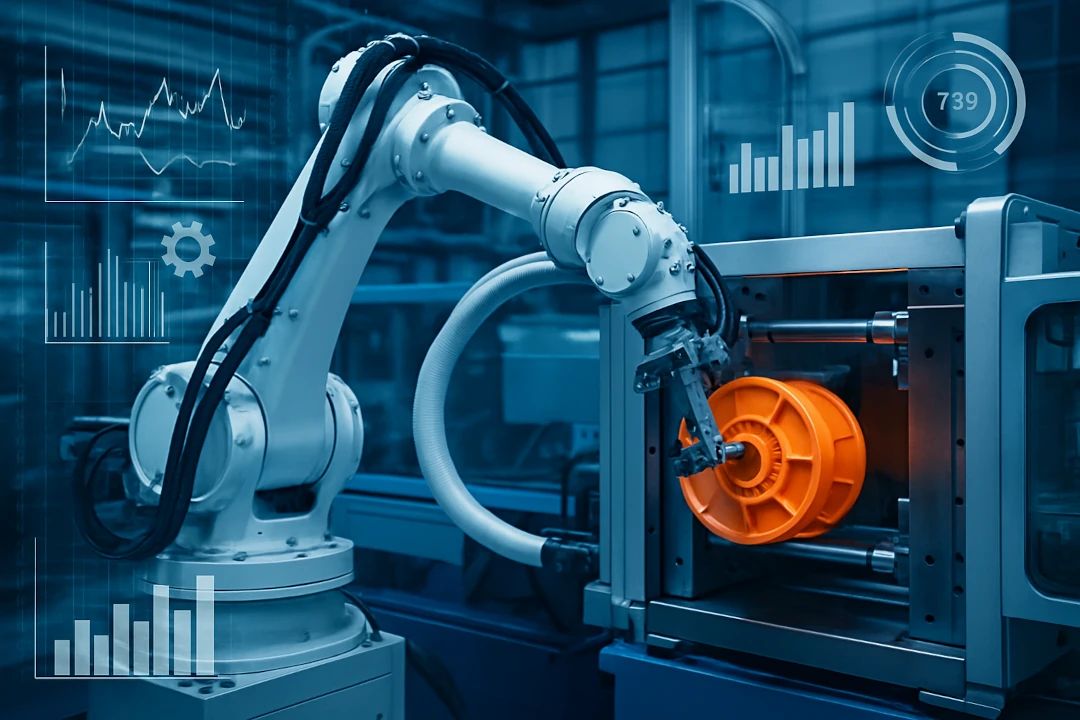Startseite » Digitalization in the plastics industry
The plastics industry has made significant progress in digitization in recent years. The adoption of new technologies, including additive manufacturing, enables companies to automate and optimize their processes. This results in higher efficiency, improved quality, and faster time-to-market.

Image: Sample illustration
Advancements in quality management are also evident through the use of data analysis and machine learning. This allows companies to detect and address trends and issues early on.
Overall, digitization remains a key driver for advancing efficiency and cost savings in the plastic industry.
The foundation for all digitization initiatives is always the integration of existing machines into data capture systems.
Machine data acquisition for plastic machines refers to the process of collecting, storing, and analyzing process data from plastic machines. This can be done using sensors, controls, and monitoring software. The collected data may include information about machine operation, production rates, energy consumption, material usage, faults, and disruptions. This data is used to improve the efficiency and performance of plastic machines, optimize processes, monitor and ensure quality, and quickly identify and address issues. Machine data acquisition is an essential component of industrial automation and plays a crucial role in enhancing the efficiency and competitiveness of plastic companies.
In the plastics industry, there are many machine manufacturers offering various equipment, including:
OPC UA (OPC Unified Architecture) is a protocol used for exchanging data in industrial automation systems. It enables the connection of machines, devices, and controllers to a central control or monitoring software. The transmission occurs through a secure, platform-independent connection, facilitating easy integration of different systems. OPC UA provides a unified and standardized interface for data exchange, leading to higher interoperability and flexibility in machine integration.
OPC UA can also be relevant for the plastics industry. As a standardized protocol for data exchange in industrial automation systems, it can be used in the plastics industry to connect machines, devices, and controllers. It enables the monitoring and control of processes, transmission of process data, and integration of various systems, which can be crucial for the plastics industry to improve efficiency, monitoring, and quality assurance.
Some machine manufacturers in the plastics industry now support OPC UA. Here are some well-known examples:
In general, when considering new acquisitions, it is advisable to check whether a particular manufacturer supports OPC UA for its machines before making a decision, in order to be well-positioned for the future.
If a machine or controller supports OPC UA, there is usually a corresponding server installed. With the following steps, a simple integration can be achieved:
Configure the OPC UA server: The OPC UA server needs to be configured to establish a connection to the machine and the OPC UA system. Information such as the IP address and port needs to be entered here.
Establish a connection: After configuration, a connection needs to be established between the OPC UA server and the OPC UA system. A common network connection like Ethernet can be used for this purpose.
Monitor and control the machine: Once the connection is established, the OPC UA system can monitor and control the machine. Data is sent from the machine to the OPC UA server and then forwarded to the OPC UA system.
Integrate applications: Finally, applications can be integrated to read and process the data. For example, SCADA software or an MES system can be used for this purpose.
You need to load content from reCAPTCHA to submit the form. Please note that doing so will share data with third-party providers.
More InformationYou are currently viewing a placeholder content from Google Maps. To access the actual content, click the button below. Please note that doing so will share data with third-party providers.
More Information